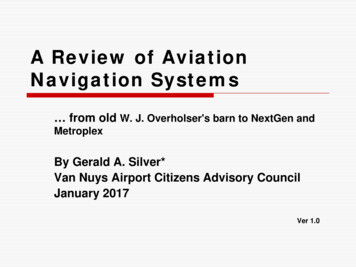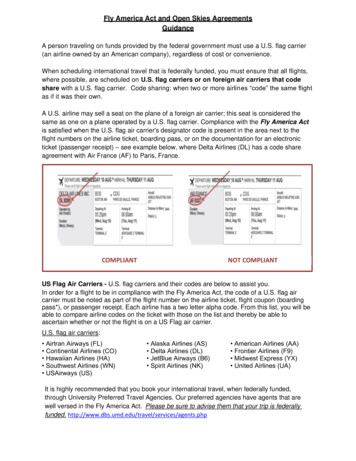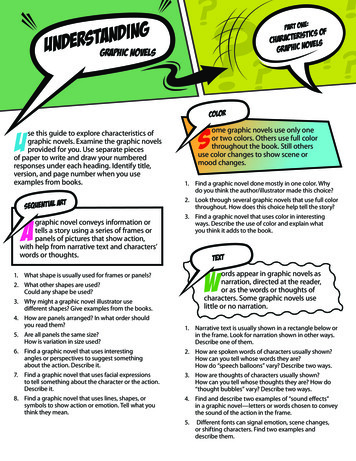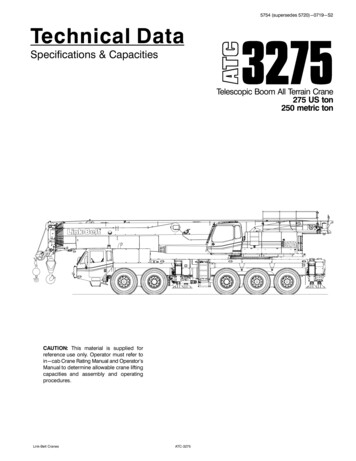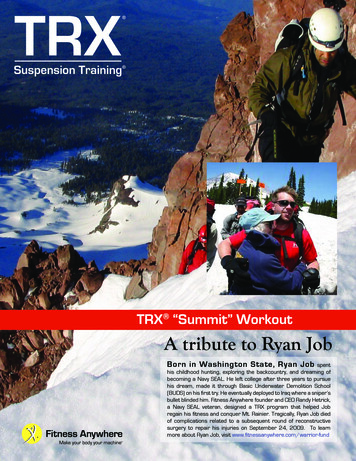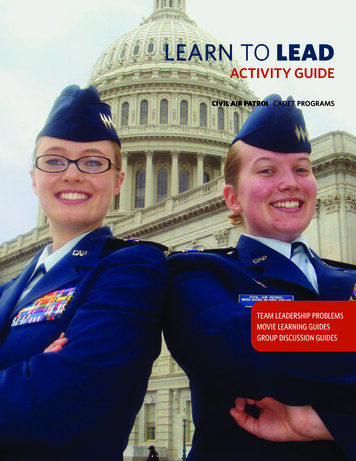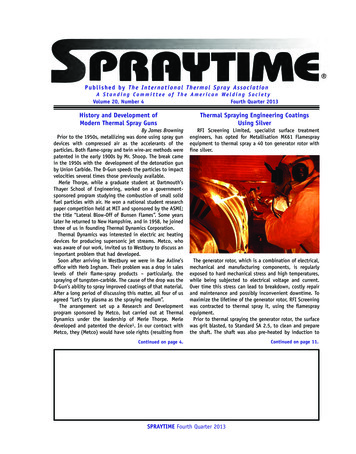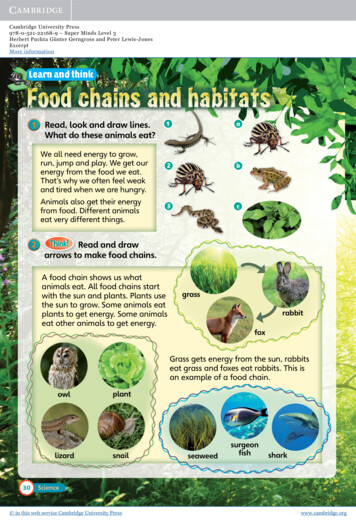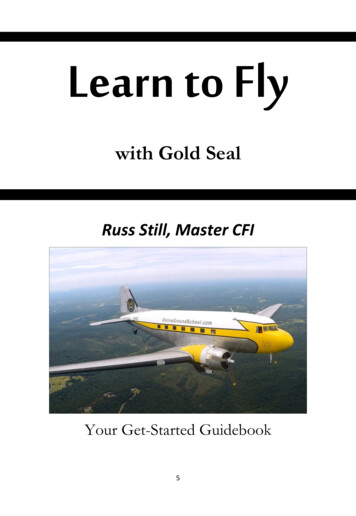
Transcription
Learn to Flywith Gold SealRuss Still, Master CFIYour Get-Started Guidebook5
Gold Seal Online Ground Schoolwww.GroundSchool.comCover photos courtesy of Jeff Rodeback and Arnaud Dachary.Thank you to the following people for the use of their aviation photographs:David Tscholl, Michael Ossipov, Arnaud Dachary, Woody Hatchett, RobertDunn, David Alders, and Ron Baak. 2013-2017 by Atlanta Flight, Inc. All Rights ReservedPrinted in the USA6
Table of ContentsIntroduction.6Section IWhat Does it Take?.10How Does it Work?.14The Airplane.19The Airport.28.35.39.46Section IIThe AirspacesThe RegulationsSection IIIBasic AerodynamicsPrivate Pilot Maneuvers.VFR Radio Communications50.60.64.70Passing the Checkride . . . . . . . . . . . . . . . . . . . . . . . . .71Aviation WeatherFlying Solo7
IntroductionBecoming a pilot is an exciting proposition. Imagine being able to hop into anairplane and soar skyward, free to go virtually anywhere you wish. See themost fantastic vistas and feel the thrill of confidence. Pilots are specialpeople who have earned a special recognition. Many people dream about it,but few ever reach the goal. You can be one of those few and you can startyour journey right now.The path you’ll take while earning your wings won’t be the easiest thing youhave ever tried. But it isn’t terribly difficult either. It will require somediligent study and practice, but it is something that you can do. It only takesdetermination and a sense of adventure.As a pilot, you will be able to fly an airplane nearly anywhere in the country.Journeys that might have taken six or seven hours in a car can be made inonly three hours in an airplane. Take your friends and family on exciting trips.Fly yourself to business meetings or visit with far-flung customers. And ifyou’re considering a career as an airline captain, the private pilot certificateis your first step.In this book, we will show you exactly what you need to know to earn yourpilot certificate as quickly and economically as possible. We will guide youthrough the process and point you toward the resources you will need.This book is a primer. It does not cover everything that a pilot needs to know.But it does introduce you to all the fundamentals you will need to getstarted. Consider it Step #1 in your new adventure.Russ Still, ATP, CFI/CFII, Master CFI8
Section I9
What Does it Take?On any given day, there are between 50,000 and 100,000 activestudent pilots in the United States. Most are working to become privatepilots, but some are working toward sport pilot certification or recreationalpilot certification. You can become one of them and it may be easier thanyou think. All it takes is the desire and commitment to go for it and see itthrough. And you don’t even need to have perfect vision.Learning to fly is not reserved for military personnel, engineers, andthrill seekers. In fact, the average student pilot is probably just like theaverage American. No special education is required to get started, and youcertainly don't have to be a genius. There is nothing involved in flight trainingthat an eighth grade science student cannot grasp. Sound easy? It really is.But don't be mistaken - the material you have to learn isn't overly difficult,but there is a lot of it. There is a lot more to flying an airplane than simplysteering it around and landing.There are two types of skills you have to master to become a pilot:the physical skills involved in actually flying the airplane, and the knowledgemastery of topics that cover everything from navigation, to aerodynamics, toweather theory. Your flight instructor will help you with the first, and GoldSeal will help you with the second.Depending on how often you fly, and how much you study on yourown, it will probably take you between three and nine months to completeyour private pilot training. A sport pilot certificate can be earned in less time,but also has fewer privileges. In either case, the more that you study, themore quickly you will complete the program and attain your goal ofbecoming a certificated pilot.Minimum Flight Training Hrs. Sport PilotFlight Time – total training hrs20Dual Instruction15Dual Cross Country2Solo Flight5Solo Cross Country1Instrument Training0Flight Test Preparation310Rec. Pilot301523003Private Pilot4020310533
The ProcessThere are a lot of flight training paths available. Different people willprefer different routes. But they all lead to the ultimate goal of becoming asafe, proficient, and legal pilot. Note that US citizens must show proof ofcitizenship prior to beginning flight training. Bring your passport or U.S.birth certificate to your first flight lesson. Students who are not citizensmust begin the process by registering with the TSA Alien Flight StudentProgram. (For more information visit www.tsa.gov.)As you progress through your training you must learn things,demonstrate proficiency to your instructor, and pass some tests required bythe FAA (Federal Aviation Administration). There are a lot of ways toaccomplish these things based on your schedule and your style.There are some common misconceptions about flight training. Themost typical one is that you simply take a written test then fly with aninstructor for some prescribed number of hours. That is sort of how theprocess works, but is a gross over-simplification.Studying for the written test (known by the FAA as the “KnowledgeTest”) is necessary, but is not an end in itself. Some of the conceptualmaterial you must learn is not covered in the written test, but you still mustmaster it. A complete program of learning will thus prepare you for morethan just the written test. Your instructor will determine whether or not youhave learned this additional material, and the examiner will verbally test youon it when you take the “Practical Test” at the end of your training.The FAA doesn’t care how you acquire the necessary knowledge. Youcan take a formal ground school where an instructor lectures to the group.Or, you can study on your own using books, CDs, DVDs, and computerizedtools. All that matters is that you learn the material.The Gold Seal Online Ground School provides complete multimediainstruction right on your computer. It should be you primary trainingresource. Sign up at www.GroundSchool.com.The flight portion of your training is not geared toward filling yourlogbook with hours. Its goal is to teach you the necessary skills, regardless ofhow many hours it takes. The FAA does set some minimums, but mostpeople take considerably more hours to attain sufficient mastery.11
RequirementsThere is no minimum age to begin flight training, although a studentpilot must be at least 16 years of age to solo. A student pilot must be at least17 years of age to take the Practical Test. This is the final exam (usually calledthe "checkride") conducted with an FAA or FAA-designated examiner. Uponsuccessful conclusion of the Practical Test, the candidate is immediatelyissued a pilot certificate.To take the Private Pilot Practical Test, a student pilot must: Be at least 17 years of ageBe able to read, speak, write, and converse fluently in EnglishObtain a 3rd-Class Medical Certificate (which doubles as the studentpilot license) - this is not required for Sport PilotsPass the FAA Knowledge Test (usually called the "written test") with ascore of at least 70%Complete a curriculum of flight training (which generally entailsbetween 50 and 80 hours of in-flight training plus some unspecifiedamount of ground training) - less training is required for Sport Pilots,but they also have fewer privilegesYou’ll find more details about all of this in the next section.12
iPad UsersIf you use an iPad with one of the popular aviation apps (such asForeflight) you will have access to digital versions of the sectional charts andA/FD data. Even though your instructor may allow you to use this in lieu ofthe “old” paper versions, we strongly recommend that you start out withpaper. There are several reasons why:(1) Paper always works – it doesn’t require electricity(2) Paper versions are used in your FAA written test(3) The examiner may require paper charts during your checkrideWhen using your iPad in the cockpit, make sure it is in a mount or kneeboard.This will help you in cockpit management and workload reduction.13
How Does it Work?Your training program may take any of a number of forms. The orderin which you do parts of it may vary. But the skills you learn and knowledgethat you master will be the same.For example, some people take the Knowledge Test before they begintheir actual flight training. Other people prepare for it during the flightportion of their training and take it whenever they are ready. The one thingthat you don’t want to do is to put if off until the end. Don’t feel the need totake the test at the very beginning, but do try to get it done by the halfwaypoint in your flight training.The specific flight skills and their required tolerances are documentedin an FAA publication called the Airman Certification Standards (ACS). Don’tbuy a hardcopy version of this. It is freely available on the internet as a .pdffile. You can download a copy from the FAA or from the Gold Seal OnlineGround School Library. Print it out and go over it with your flight instructor.The ACS dictates precisely what must becovered during your Practical Test.Obviously, you will want to know what isexpected of you in advance. This is animportant document and you should referto it frequently throughout your training.14
Your training program will roughly follow this 3)(14)(15)(16)Select a flight school or flight instructor.Learn the basic flight skills needed for solo flight. These include theobvious skills of takeoffs and landings. But they also include severalbasic flight maneuvers along with the knowledge of regulations,airport operations, and radio communications. (See Section III)Unless you are training for light sport, get your FAA medicalcertificate. This FAA page will help you find a medical y for your Student Pilot Certificate at iacra.faa.gov. Your flightinstructor will help you with this.Begin studying for the FAA Knowledge Test. Much of this is materialis needed for your day-to-day training flights.Prepare for a pre-solo written test that your instructor will provide.Continue learning more advanced flight skills with your instructor.Solo! This is your first flight by yourself. It generally entails threetakeoffs and landings at your training airport. It is your first majormilestone. Don’t worry – your instructor will know when you areready for this important event.Continue learning more advanced flight skills with your instructor.Take, and pass, the FAA Knowledge Test.Solo practice.Cross country flights with your instructor.Solo cross-country flights.Night flight training with your instructor.Preparation for the FAA Practical Test. This includes an oral portionand a flight portion, conducted with an FAA (or FAA-designated)examiner. The requirements for this are documented in the AirmanCertification Standards.Take, and pass, the FAA Practical Test. After you pass this test youwill be issued a temporary Pilot Certificate identifying you as a fullycertificated Pilot.15
Tools of the TradeCertain items are needed by pilots. This list contains the basics that you willneed as a student pilot.(1) FAR/AIM – book of FAA regulations (new one every year)(2) Sectional Chart – an aeronautical chart of your geographical area(3) A/FD – Airport/Facility Directory (contained in the “ChartSupplement” booklet); provides information about airports in yourgeographical area (updated every 56 days)(4) Flight Computer – inexpensive mechanical or electronic device orsmartphone app used to make specific types of calculations(5) Plotter – a clear plastic gage used to measure distances and plotmagnetic headings on charts(6) Headset – your instructor or flight school may provide you with oneto use during your training but you will eventually want to purchaseyour own (airplanes are noisy!)(7) Small electronic calculator(8) Text books – your instructor or flight school will probably suggestspecific texts for your study; the FAA’s Pilots Handbook ofAeronautical Knowledge and The Airplane Flying Handbook are goodoptions16
The Written TestJust about every student pilot puts the FAA Knowledge Test at the topof the list of hurdles. Many assume that it is the main reason they have tostudy or attend a ground school. That’s not quite the case.First, the written test is not just some obstacle that the FAA hasplaced in your path. It is not an issue of jumping through a hoop. Thematerial it covers is, for the most part, very important in the day-to-dayduties of a pilot. It really is stuff you need to know.Second, the study you do during your training is not just for thewritten test. There is a lot of pilot material that is not covered in the test, butyou still need to master it. Don’t make the mistake of cramming for thewritten test and think that’s all there is to it. Study from a complete groundtraining program.The Knowledge Test is composed of 60 multiple choice questions. Aminimum score of 70% is required to pass. In the past, the questions camefrom a published bank of over 700 possible questions. Thus, many students,too many actually, simply studied the questions and answers in preparationfor the test. Easy, but ineffective in the grand scheme of things.The FAA recognized that this was happening, and started adding newquestions with more frequency. Next they only published a partial list of thequestions. Finally, they stopped publishing a precise list altogether.As you study for the written test, by all means, take advantage of thesample quizzes available online. Study the old questions. But commit yourselfto a thorough study of all the conceptual material, not just the questions youthink may appear on your exam.In Section II, you’ll be introduced to the basic knowledge subjectsrequired of pilots. It’s a quick overview of the fundamentals. You will learnmore of the details as your training progresses. There is nothing that willimpress your instructor more than for you to walk through the door with agood foundation in the principles of aviation.Being prepared and studying on your own will expedite your trainingas well as save you money. For more tips on saving money, see the article inthe Gold Seal Online Ground School Library entitled “The Cheapest Way toBecome a Pilot”.17
Section II18
The AirplaneAirplanes are the most common form of aircraft in the FAA Category.Other types of aircraft include balloons, gliders, and rotorcraft such ashelicopters. While you could do your private pilot training in a multi-engineairplane, it is more likely that you will train in a light single engine airplane.Models frequently used for training are manufactured by companies such asCessna, Piper, and Diamond.Airplane StructureThe main body of an airplane is called the fuselage. It extends fromthe tail to the firewall and upon it are mounted the engine, wings, landinggear and tail section (which is called the empennage). The cabin or cockpit islocated inside.When air flows over an airplane’s wings, an upward force called lift isgenerated. Lift is what enables an aircraft to remain in the air. In flight, an19
airplane moves in three dimensions. Control surfaces on the exterior of theairplane allow the pilot to maneuver the airplane. Two of these controlsurfaces, the ailerons and elevator, are manipulated using the yoke (or insome airplanes, a control stick). A pilot controls a third control surface, therudder, by pressing foot pedals. These same foot pedals are also used tosteer the airplane on the ground.Elevator – Controls pitch; the nose of the airplane moves up or downAilerons – Control roll; as one wing goes up, the other goes downRudder – Controls yaw; the nose of the airplane moves side to sideThe coordinated use of all three control surfaces allows the pilot tosmoothly maneuver the airplane in three dimensional space.Another type of control surface, called flaps, is used to assist inlandings. Pilots generally land with the flaps extended, but during yourtraining, you will learn to land with or without them. In some airplanes, flapsmay also be used during takeoffs to get the airplane airborne more quickly.There are several types of flaps. Most are used to increase lift at lowerairspeeds.Thrust, the force that moves the airplane through the air, isgenerated by the turning motion of the propeller. In the early days of flight,the propeller was frequently called the airscrew. And honestly, that’s a prettydescriptive term. It pulls the airplane through the air just like a screw pullsitself through wood. As the airplane moves forward, air rushes over thewings creating lift, and there you are – flying!20
Training AirplanesTwo popular training airplanes are the Cessna 172 and Piper Warrior.Both carry up to four people and both have similar handling characteristics.Because the Cessna, shown above, has high wings, you are given agood view of the ground, but an obstructed view above and to the sides. ThePiper, shown below, provides a better view around you, but a poorer view ofthe earth’s surface. So which one is better? That’s a long-standing debatethat will likely never be answered. Both are excellent for training.21
The Diamond DA-20 and DA-40 models are also used frequently as trainingaircraft. They have a more modern design and are operated with a controlstick instead of a yoke.Airplane InstrumentsWhile flying, pilots must be able to monitor a variety of factorsaffecting the airplane. These include things like airspeed, altitude, heading,and the airplane’s attitude. Attitude refers to the airplane’s position in 3Dspace. As we discussed earlier, an airplane’s motion revolves around 3 axes.The motions about these axes are called roll, pitch, and yaw. The instrumentsthat display this information are called flight instruments. Pilots frequentlycall these the “six pack” because the round dials look something like a sixpack of canned drinks.To assist with navigation, instrument panels will also includenavigation instruments. These work in conjunction with the navigation radiosand, if present, the GPS receiver.Finally, there are the engine monitoring instruments. In most trainingairplanes these include a tachometer (which shows engine RPM), an oiltemperature gage, an exhaust gas temperature gage, and an oil pressuregage.22
In this picture we see the “six pack” of standard flight instruments.They may look slightly different in your training airplane, but this is basicallyhow they are laid out. In this example, the airplane is sitting motionless onthe ground – that explains why the Airspeed Indicator and Altimeter bothshow zero.Airspeed – An aircraft’s speed is measured as airspeed, not groundspeed. Airspeed indicates the aircraft speed within the air mass. The airmass, itself, will usually also be moving. Ground speed is the speed at whichthe aircraft moves over the ground. Obviously, the ground is stationary.Airspeed and ground speed will usually be different. They will only be thesame when the air is totally calm.Altitude – Altitude is generally measured in feet above mean sea level(MSL). The reason for this is simple. Terrain goes up and down. But airplanesreporting their altitudes over the radio must use a measure in terms of somestandard starting point. Altimeters operate based on barometric pressure.The current pressure is entered into the altimeter by the pilot prior totakeoff. During cross-country flights, the pressure setting must be updated.23
Shown above is a Cessna 172 with a panel of conventionalinstruments. Although they use older technology, they are still accurate andreliable. The rectangular stack to the right of center contains the radios andother navigational avionics devices.Below is a Cessna 172 with a more modern instrument panel. Thisone is the Garmin G-1000. It is frequently referred to as a “glass panel”. Inspite of all the computer displays, it gives the pilot the same informationprovided by a conventional instrument setup.24
Rental prices on airplanes with glass panels such as the G-1000 willlikely be higher than fees for airplanes with conventional instruments. Mostnewer airplanes are being manufactured with glass panels, but there remaina huge number of older airplanes.Unlike cars, airplanes from the 1960s and 1970s are not “too old.”Planes are not generally discarded when they pass their tenth birthday.Owners keep them fresh and safe with extensive maintenance.Training in an older airplane can be just as safe as training in a brandnew one. Complete inspections, conducted by FAA licensed mechanics, arerequired of all airplanes used in commercial training. When maintainedproperly, older airplanes can provide a great opportunity for you to savemoney.If you decide to train in an airplane with a G-1000, take advantageof Gold Seal’s online training course at www.Fly1000.com. It’s an easy wayto get yourself up to speed quickly with this exciting new technology.Airplane EnginesMost single-engine airplaneshave four-cylinder, fourstroke, air-cooled enginesmanufactured by Lycoming orContinental. LSA (light sport)airplanes frequently usesmaller engines manufacturedby companies like Rotax.These may be two-stroke orfour-stroke engines.An airplane’s battery is used to start the engine, but once it isrunning, the sparks plugs are fired from devices called magnetos. If theelectrical system fails in flight, the spark plugs will continue to receiveelectricity from the magnetos and the engine will remain running.Most airplane engines are designed to burn 100LL aviation gasoline,referred to as avgas. This fuel has a distinctive blue color. When fueling, it isimportant for pilots to ensure that the proper type of gasoline is pumped.25
Fuel is tested by draining a small amount from valves under the wingsand engine compartment into a clear receptacle. The pilot can then visuallyconfirm that the fuel is the proper blue color and contains no water or othercontaminants. This is part of the standard preflight inspection that isperformed by the pilot before every flight.Additionally, fuel in the tanks must be manually checked for quantityby inserting a marked stick or tube into the tanks. There are fuel quantitygages on the instrument panel but these are notoriously inaccurate. Alwaysconfirm the amount of fuel manually prior to flight.Also during the preflight inspection, the oil dipstick is checked tomake sure that engine contains an adequate amount of oil. This will rangefrom six to twelve quarts depending on the specific engine.As a pilot, it is your responsibility to know exactly how much fuel andoil your airplane engine carries and to confirm that there are adequateamounts for flight. You must also know how many gallons of fuel the airplaneburns per hour. Knowing that and how many gallons are in the tanks allowyou to calculate how long you can fly. Regulations require that you carry aminimum of 30-minutes worth of reserve fuel. For safety, always have atleast an hour’s worth more than you need for the flight.The power control for an airplane engineis the throttle, operated with the pilot’s righthand. Pushing it in causes more fuel to flow andthe engine’s RPM (revolutions per minute) toincrease. Engine RPM is measured with a gagecalled a tachometer. Most people refer to itsimply as the “tach”. In airplanes with acontrollable-pitch propeller (known as a“constant-speed” propeller), engine power ismeasured instead by a manifold pressure gage. Most training airplanes willnot have a constant-speed prop.Fuel SystemsMost training airplanes have fairly simple fuel systems consisting oftwo fuel tanks, one in each wing, a fuel selector valve, and either acarburetor or fuel injection system to deliver fuel to the engine.26
Carburetors take fuel and air, mixing them into a mist. This mist issucked into the engine cylinders for ignition by the spark plugs.Fuel-injected engines handle the fuel delivery issue a bit differently.Fuel is pumped from the tanks into a control unit which mixes it with air. Thefuel/air mixture is then piped into a fuel manifold which distributes it to thecylinders where it is directly injected.27
The AirportIf you mention the word airport to a nonpilot, most people immediately think you’retalking about the large complexes wherecommercial passenger jets operate. If theyhave a small municipal airport in their owntown, they might not even be aware it exists.Most Americans would be surprised to learn that there are over 5,000 publicuse airports in the United States. And subject to some restrictions, if you’re apilot, you can fly in and out of any of them.Some airports have a control tower. At these, a controller verballydirects all traffic via the radio. At non-towered airports, pilots followstandard practices and announce their movements on a frequency specific tothat airport. This frequency is called the Common Traffic Advisory Frequency(CTAF). Pilots must understand and abide by specific rules when operating atany airport.28
Airport LayoutWhile airports vary widely in their physical layouts, there are majordistinctions that are common to all of them.Control Tower – A physical building, usually in a tower, where controllersmonitor and direct aircraft operations. There are special rules for operationsat these airports including the requirement for pilots to maintain radiocontact with controllers. Airports with towers are normally designated asClass B, Class C, or Class D. Smaller airports frequently are non-towered andare designated as Class G or Class E.Runways – Used for aircraft takeoff and landing operations. Runways may bepaved or they may be “unimproved” (grass, dirt, etc.). Runways are identifiedby numbers that correspond to their approximate magnetic headings. Forexample, Runway 27 faces to the west on a heading of 270 . At toweredairports, aircraft must be cleared to takeoff or land by the tower controller.At non-towered airports, it is the pilot’s responsibility to announce his or herintensions on the Common Traffic Advisory Frequency.Taxiways – Used for taxi operations, that is, ground movement of vehicles.Taxiways are bordered by blue lights and marked by yellow centerlines, andthey are identified by alphabetic letters or combinations of a letter and anumber. At towered airports, aircraft must be cleared to taxi by the groundcontroller.FBO – Fixed Base Operator. This is generally a business that services aircraftand crew with parking facilities, fuel, maintenance, and amenities. Mostairports will have at least one FBO, but some smaller airports may not haveany. Flight schools and independent instructors (CFIs) sometimes operatefrom an FBO. Pilots usually check on the availability of FBO services beforevisiting an airport for the first time.Standard Signage – Airports are covered with signs assisting pilots in locatingtaxiways and runways. There are also standard signs instructing pilots incertain operations. Every pilot must be familiar with the standard signage.Airport Identifier – A three or four-digit code that identifies each airport.Pilots are expected to know these identifiers for the airports they may bevisiting or using as waypoints. These codes are shown on aeronautical chartsand in the Airport/Facility Directory (contained in the Chart Supplement).29
The legal source for airport information is the Airport/FacilityDirectory (A/FD). It is contained in an FAA publication called the ChartSupplement. This little green book is published every 56 days and providesdescriptions of every public use airport in your area. It should be consideredyour primary reference for airport information.As a student pilot, you will use the A/FD to learn about any airportprior to visiting it. Additionally, some questions on the FAA Knowledge Testrefer to the A/FD so you will need to be very familiar with it.This is the entry in the A/FD for Atlanta’s DeKalb-Peachtree Airport. Itlists geographic information about the airport, runway data, remarks, radiofrequencies, and information about radio navigation aids.30
This airport diagram depicts DeKalb-Peachtree Airport (PDK). Noticethe two parallel runways. Since they share the same magnetic heading, theletters “L” and “R” are appended to designate left and right.31
Compare this overhead image of PDK with the airport diagram on theprevious page.32
The Traffic PatternAirplanes landing at an airport enter into the airport’s traffic pattern.This is a rectangular flight path that usually exists 1000 feet above thesurface. At some airports, the traffic pattern may exist at 800 feet aboveground level (AGL) or may even exist at some other specific altitude. 1000feet AGL is the norm, but refer to the A/FD to determine the proper trafficpattern altitude (TPA) at any airport you visit.Traffic patterns are divided into legs called the crosswind, downwind,base, and final as shown in this diagram.WINDRight CrosswindLeft CrosswindLeftDownwindRightDownwindLeft BaseRight Base33
As a standard, traffic patterns move in a counterclockwise direction.This is called “left traffic” because all turns in the pattern are to the left.Some airports have non-standard patterns and use right traffic. And to makethings even more complicated, sometimes the pattern direction differsbetween each runway at a single airport. Again, check the A/FD to determinewhich is appropriate.Airport SymbologyAirports ar
issued a pilot certificate. To take the Private Pilot Practical Test, a student pilot must: Be at least 17 years of age Be able to read, speak, write, and converse fluently in English Obtain a 3rd-Class Medical Certificate (which doubles a
